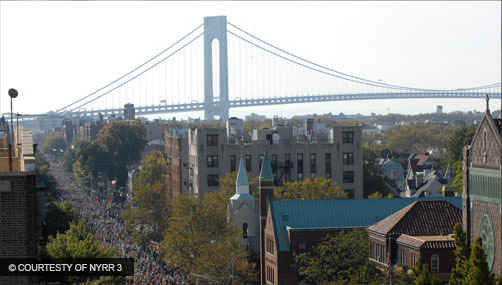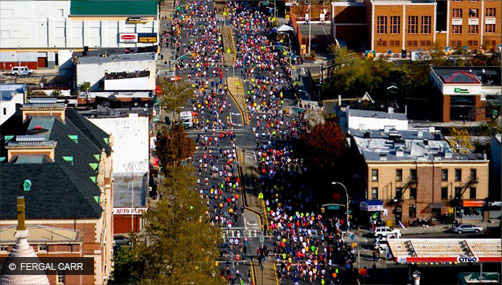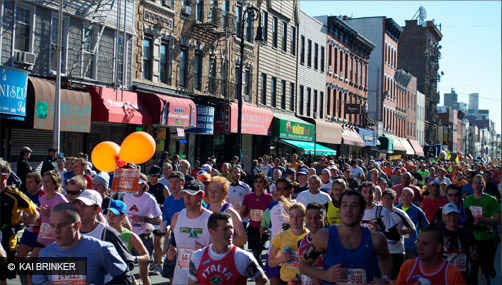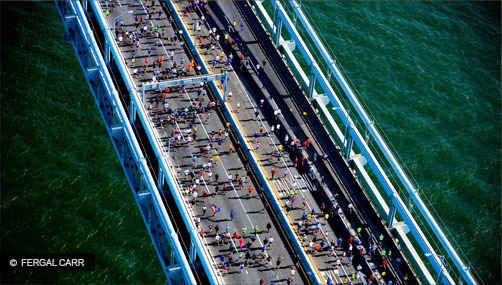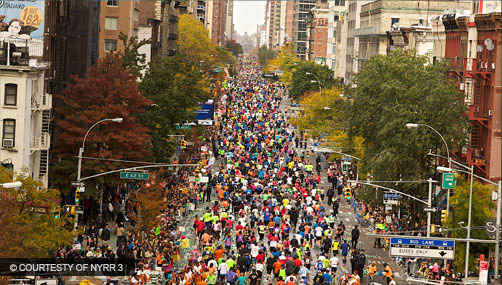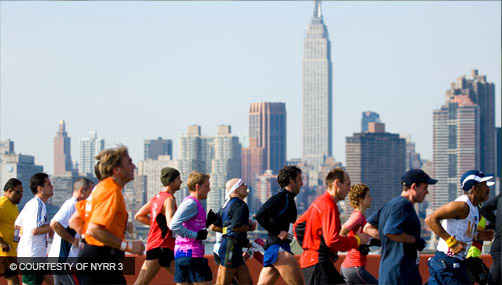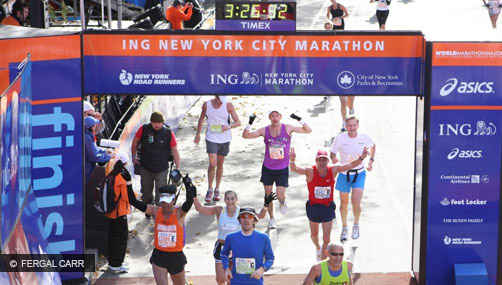BIOGRAPHY
The New York City Marathon is the most popular race of its kind (42.195 kilometres) held annually in the world.
It is traditionally held on the first Sunday in November. It was founded in 1970 by Fred Lebow (1932-1994) and organized by the New York Road Runners, the club he was president of. Only 127 runners competed in the first race, paying a registration fee of $1. Only 55 competitors crossed the finish line after completing a circuit that consisted of several loops around the Park Drive of Central Park, on the island of Manhattan. Six years later, Lebow decided to redesign the course so that it traversed all five boroughs of the city, from Staten Island to Manhattan, through Brooklyn, Queens and the Bronx. He managed to raise participation to 2,090 athletes, including Olympic Marathon champion Frank Shorter, and to catch the attention of the media and residents, who lined the entire route to cheer on the runners. Since then, the New York Marathon –integrated in the World Marathon Major along with the Boston, Chicago, Tokyo, Berlin and London Marathons– has grown steadily, becoming an athletics event of international scope in which more than 50,000 participants, including professionals and amateurs, currently cross the finish line.
With its course traversing the entire city, the New York City Marathon became an event which began to appeal to some of the top runners in the world at this distance due to bringing together sport, civic spirit and media coverage. In 1978, more than 9,000 runners competed in the race for the first time; a race in which the Norwegian long distance runner Grete Waitz set a new course record for women by completing the distance in 2 hours 32 minutes and 30 seconds. Waitz is also is the athlete to have won this race on the most occasions; nine times in all. In the 90s, African athletes began to come to the front and, in 1994, Kenyan Tegla Loroupe demonstrated with her first victory in the women’s category that African women runners were on the same level as men. This opened the gates for women to be invited to participate in other international long distance races. In 2000, the organization included an official wheelchair division, which over time has also become the most competitive race in the international arena at this distance and which also includes athletes using handcycles and those with other types of disabilities.
The growth of the New York City Marathon has led to popular participation currently being chosen via a lottery system among those enrolled. In 2013, more than 50,000 runners completed the race, making this the largest marathon anywhere in the world. The holding of the race is also accompanied by a week of events and exhibitions for runners, their relatives and those accompanying them. To achieve all this, the organization mobilizes more than 9,000 volunteers, who work during the activities leading up to the marathon and on the day of the race itself, standing along a course lined by more than two million spectators. The only cancellation in the history of New York City Marathon took place in 2012, following Hurricane Sandy, although thousands of people gathered in Central Park to run, thus reinforcing the symbolism of this test. The next race, which was won in 2013 by Kenyans Geoffrey Mutai and Priscah Jeptoo, will take place on 2nd November this year.
Photo Gallery
Stories
-
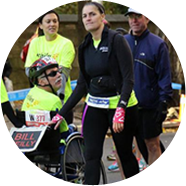
They Worked Together for 26.2
Runner
Bill Reilly is an experienced New York City Marathon participant, with 15 five-borough runs to his credit, but his view of the course is a little bit different. Reilly, who has cerebral palsy and is a member of Achilles International, competes in a three-wheeled racing wheelchair. He uses the strength in his legs to push himself forward while facing backward.
more [+]
Reilly and other athletes with disabilities start the marathon ahead of the main field. On November 3, his three volunteer guides—Harold Chayefsky, Wendy Furtado, and Ariel Krieger—ran alongside him for 26.2 miles. They train with Reilly, and they often alternate duties on runs, one sprinting ahead to keep the course clear, while the other two stay behind to steer the wheelchair—which is no mean feat on crowded sections of the course, like First Avenue in Manhattan.
For Reilly and his team, this year’s cold, windy conditions were an added challenge. What is often an 18-minute first mile up the Verrazano-Narrows Bridge clocked in closer to 22 minutes. Through the difficult sections, Reilly held on to one thought: “Keep moving.”
Although his finishing time of 7:39:30 fell short of his 6:30 goal, he kept a positive attitude—with his guides’ help—throughout the day. Krieger says that the spectators along the route also helped the team keep moving. “Every neighborhood has such great character,” she says. “Even if you’re tired or sore, the energy is so awesome.”
The team was back training together soon after the marathon, and they’re already looking toward the next challenge. Reilly said that he felt “no pain” after the tough day’s run, and Furtado added, “This guy’s a pro.”
cerrar -
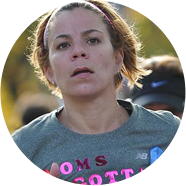
She Ran Staten Island Strong
Runner
A year after she lost her home during Superstorm Sandy, Staten Island resident Jen Correa completed her first-ever ING New York City Marathon on November 3, 2013.
Correa has spent the past 12 months working to rebuild her family’s lives. “It’s a polar opposite of feeling,” she said after finishing the marathon, “from the worst experience to feeling like I was on top of the world.”
more [+]
The Brooklyn native grew up just across the Verrazano-Narrows Bridge from Staten Island. “There was nothing to prepare me for the energy on that mile-two downhill into Brooklyn,” she said of the opening miles of the marathon on November 3. She got an additional boost from seeing her mother cheering on Fourth Avenue.
The excitement of running her hometown’s marathon, combined with the support from spectators throughout the 26.2-mile route, propelled Correa to a finishing time of 4:29:45. “I ran by myself, but I never felt alone,” she said.
She views the marathon as a symbolic end to her yearlong path to recovery following the storm, and she looks forward to settling in a new home with her husband and two children. They want to stay in Staten Island. Correa explained: “Staten Island does come with a lot of memories, but a lot of them are good memories. We all went through it together, and I want to be in a place that I know is strong.”
Looking to the future, Correa said, “This next chapter for me is about paying it forward.” She hopes to use her experience in the wake of Sandy to help others who find themselves facing similar challenges. Soon after the marathon, she and many of her fellow Staten Islanders banded together to collect items for families in the Philippines who were displaced by Typhoon Haiyan.
With 12 difficult months behind her and a brighter future ahead, Correa reflected, “I didn’t know how to get my head around Sandy, but everything happens for a reason, and I’m stronger for it.”
The team was back training together soon after the marathon, and they’re already looking toward the next challenge. Reilly said that he felt “no pain” after the tough day’s run, and Furtado added, “This guy’s a pro.”
cerrar -
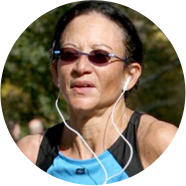
She's Looked at Marathons from Both Sides Now
Spectator
Susan Branche watched her first New York City Marathon by accident. In 1980, while in graduate school at Columbia University, she was on a run when she saw a crowd gathered at the entrance to Central Park at 90th Street and Fifth Avenue. Minutes later, she was amazed to see Alberto Salazar powering by en route to his first of his three consecutive wins.
Inspired by the spectacle of thousands of runners pushing themselves to complete 26.2 miles, Branche would revisit that spot on Fifth Avenue each November to cheer. She noticed that the crowd grew with each successive year, indicative of the marathon's growing presence in the city. Each year, she felt the same heart-pounding adrenaline rush. She found herself thinking, “I've got to try this myself sometime.”
more[+]
In 1992, Branche followed through on her promise to herself, completing her first of five New York City Marathons. Having experienced the race from both outside and inside, she says that as a runner, the crowds are the most enjoyable part: “The New York crowds are unbeatable in number, diversity, and enthusiasm.”
During the 2011 race, she recalls, a woman on First Avenue shouted “You are all so incredibly beautiful!” to the waves of runners. In 2005, her two sons made signs to support her and to be more visible as she ran by them. She still has the signs.
Branche, now a psychologist living in Scarsdale, NY, has come to know from her experience where runners need support the most, and how to stand out in the crowd of spectators. She won't be running this year, but she plans to watch in Harlem, encouraging runners as they approach the course's final tough miles.
She looks forward to that same adrenaline rush that keeps her coming back every Marathon Sunday. “When I'm injured or taking time off from running, I want to cheer,” she says. “The crowds make such a difference and it's such an exciting thing to do.”
Branche will push herself to shout and cheer for as long as possible on November 3. “I'm determined to be out there for the duration—to see the professionals, my friends, and everyone else,” she says. “I'll be out there as long as my lungs can hold out.”
cerrar -
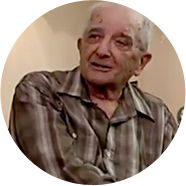
A Long-Serving Volunteer Inspires All
Volunteers
If you've ever run the New York City Marathon, there's a good chance you were helped on your journey by Carmine Santoli.
The 87-year-old Santoli has been captain of the mile 6 fluid station, on Fourth Avenue in Brooklyn, for over three decades. Year after year, he's mobilized his neighbors to set up the station and distribute fluids to passing runners on race day. It's always been a family affair for the Santolis; Carmine's son, Philip, has long served as co-captain.
more [+]
Through his many years of service, Santoli has seen countless runners pass mile 6, including world-class athletes and celebrities. His favorite marathon memory is of NYRR legend Fred Lebow. “He rode on the hood of a car one year,” Santoli recalls, “and as they passed our water station, he asked the driver to stop. Fred shook my hand, and thanked me for everything I'd done.”
Sadly, Santoli has suffered poor health and will be unable to manage the fluid station this year. But he's determined to come out and cheer for the runners, and he's passed the torch to one of his extraordinarily capable co-captains, Alex Duarte.
To honor Santoli's incredible service, mile 6 will be called the “Carmine Santoli Celebration Mile.” Give a wave as you grab a cup of water or Gatorade on Fourth Avenue near 23rd Street. You'll be honoring the spirit that makes Marathon Sunday special for this community.
cerrar
- Runner
- Runner
- Spectators
- Volunteers
Minutes of the Jury
At its meeting in Oviedo, the Jury for the 2014 Prince of Asturias Award for Sports, made up of Jesús Álvarez Cervantes, Alejandro Blanco Bravo, Emilio Butragueño Santos, Óscar Campillo Madrigal, Miguel Carballeda Piñeiro, Marisol Casado Estupiñán, José María Casanovas i Punti, Joaquín Folch-Rusiñol Corachán, César González Antón, Gemma Mengual Civil, Javier Muñoz Gallego, Santiago Nolla Zayas, Juan Antonio Paredero Moreno, María Rodríguez Escario, Eduardo Roldán Oses, Amaya Valdemoro Madariaga, Emilio de Villota Ruiz, Theresa Zabell Lucas, chaired by Josep Lluis Vilaseca i Guasch and with Julián Redondo Pérez acting as secretary, has decided to grant the 2014 Prince of Asturias Award for Sports on the New York City Marathon, one of the largest sporting events in the world. Since its creation in 1970, when only 127 runners participated, it has become the foremost popular race of its kind, symbolizing coexistence between amateur and professional sport at its best, with more than 50,000 competitors taking part in last year’s race. This ultimate expression of sport, citizen involvement and the spirit of solidarity is reflected on the first Sunday in November each year in a tradition boasting major media coverage, in which the entire city is infused with collective enthusiasm to run the legendary 42 kilometres and 195 meters.
Oviedo, 18th June 2014





